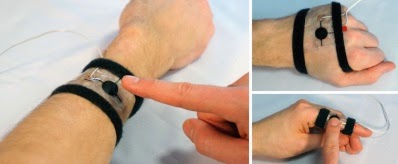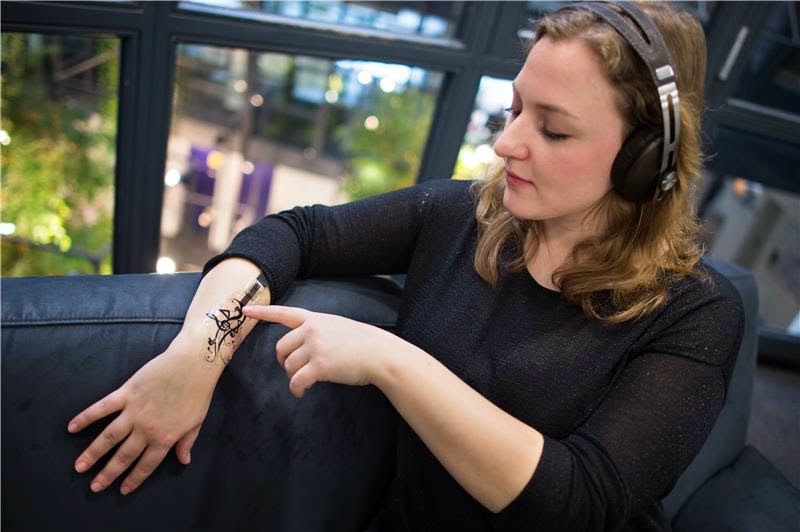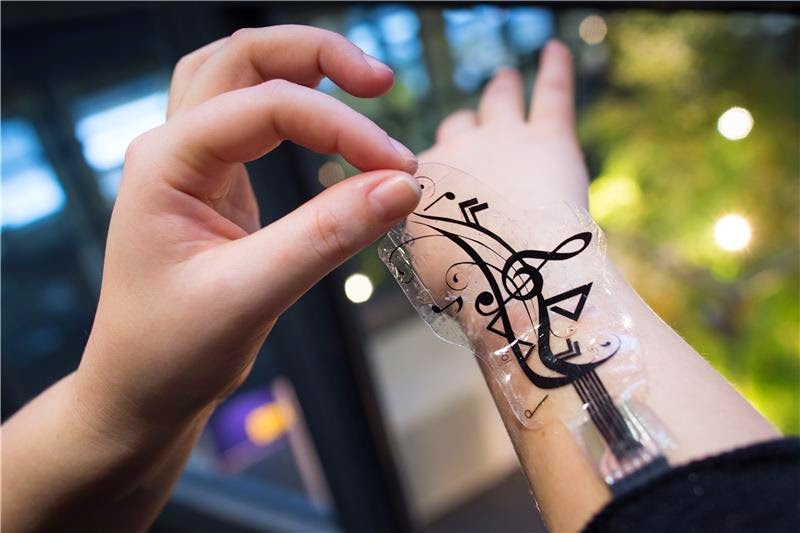| Online: | |
| Visits: | |
| Stories: |

| Story Views | |
| Now: | |
| Last Hour: | |
| Last 24 Hours: | |
| Total: | |
Sensors Turn Skin into a Touch-Sensitive Interface for Mobile Devices
If a mobile phone rings during a meeting, its owner often has to dig it out before it can be muted. A more discreet method would be to decline the incoming call by pressing on one of your fingers. Computer scientists at Saarland University are studying the potential use of the human body as a touch sensitive surface for controlling mobile devices. They have developed flexible silicone rubber stickers with pressure-sensitive sensors that fit snugly to the skin.
The novel class of skin-worn sensors for touch input on the body. iSkin is a very thin sensor overlay, made of biocompatible materials, and is flexible and stretchable. It can be produced in different shapes and sizes to suit various locations of the body such as the finger, forearm, or ear. Integrating capacitive and resistive touch sensing, the sensor is capable of detecting touch input with two levels of pressure, even when stretched by 30% or when bent with a radius of 0.5 cm.
Furthermore, iSkin supports single or multiple touch areas of custom shape and arrangement, as well as more complex widgets, such as sliders and click wheels.
Computer scientists at Saarland University and Carnegie Mellon University are studying the potential use of the human body as a touch sensitive surface for controlling mobile devices. They have developed flexible silicone rubber stickers with pressure-sensitive sensors that fit snugly to the skin.
By operating these touch input stickers, users can use their own body to control mobile devices. Because of the flexible material used, the sensors can be manufactured in a variety of shapes, sizes, and personalized designs, and can used for a variety of applications, such as extending functions of a smart watch.
Study setup on participants’ forearm, back of the hand, and finger. Two straps of Velcro allowed for fast, easy attachment.
The iSkin uses touch-sensitive stickers use electrically conducting sensors that can be worn anywhere on the skin, made from flexible, stretchable silicone.
Researchers have developed a variety of flexible, stretchable skin sensors, as KurzweilAI has reported. This new development focuses on sensors as mobile-device interfaces.
Give me some skin
‘The stickers allow us to enlarge the input space accessible to the user as they can be attached practically anywhere on the body,” explains Martin Weigel, a PhD student in the team led by Jürgen Steimle at Saarland University. Applying pressure to the sticker could, for example, answer an incoming phone call or adjust the volume of a music player. Or a keyboard sticker could be used to type and send messages. A sticker could be rolled up and put in a pocket, explains Steimle.

Credit: Martin Weigel et al./CHI ’15)
Users can also design customized (bespoke) designs for iSkin patches on a computer, using a simple graphics program to create different shapes.
“The patches are ‘skin-friendly,’ as they are attached to the skin with a biocompatible, medical-grade adhesive,” said Steimle. “Users can decide where they want to position the sensor patch and how long they want to wear it.”
Currently the sensor stickers are connected via cable to a computer system. According to Steimle, microchips may in the future allow the skin-worn sensor patches to communicate wirelessly with other mobile devices.
The researchers will present their iSkin project March 16 to March 20 at the CeBit computer expo in Hanover, Germany and at the SIGCHI conference in April in Seoul, Korea. This work has partially been funded by the Cluster of Excellence on Multimodal Computing and Interaction within the German Federal Excellence Initiative.l
iSkin: Flexible, Stretchable and Visually Customizable On-Body Touch Sensors for Mobile Computing
Someone wearing a smartwatch can look at a calendar or receive e-mails without having to reach further than their wrist. However, the interaction area offered by the watch face is both fixed and small, making it difficult to actually hit individual buttons with adequate precision.
A designer can freely choose the shape of the sensor by cutting the surrounding PDMS into the desired shape. This allows for a better fit on various body parts but can also enhance the visual appearance of the sensor
Design Patterns for Visual Customizations: (a) fully touch-sensitive graphic, (b) partially sensitive graphic, (c) graphic with multiple interactive areas, (d) touch-sensitive detail using inverse and color patterns, (e) non-sensitive visual elements, and (f) shape customization.
In addition to controlling music or phone calls, the iSkin technology could be used for many other applications. For example, a keyboard sticker could be used to type and send messages. Currently the sensor stickers are connected via cable to a computer system. According to Steimle, in-built microchips may in future allow the skin-worn sensor patches to communicate wirelessly with other mobile devices.
iSkin builds on and extends recent advances in research on electronic skin. iSkin is a proof of concept of on-skin touch sensing that bears some promise over rigid sensors and computer vision based solutions. iSkin supports touch input on the skin
Citation: iSkin: Flexible, Stretchable and Visually Customizable On-Body Touch Sensors for Mobile Computing. Proceedings of the SIGCHI Conference on Human Factors in Computing Systems. Martin Weigel, Tong Lu , Gilles Bailly , Antti Oulasvirta , Carmel Majidi , Jurgen Steimle. DOI: 10.1145/2702123.2702391
Source: http://www.ineffableisland.com/2015/03/sensors-turn-skin-into-touch-sensitive.html








